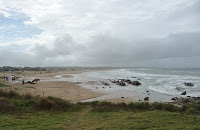 Heading north from Montevideo, the first sizable town you encounter is the 1930s resort town of Piriapolis, built and owned by chemist/entrepreneur Francisco Peria. Centered around his massive Hotel Argentino and nestled up against some of Uruguay's highest hills, it has a mediterranean feel to it. In its heyday, it was host to the wealthy, royal and famous. Today, it has more of a family feel. It's my favourite beach town on the strip.
Heading north from Montevideo, the first sizable town you encounter is the 1930s resort town of Piriapolis, built and owned by chemist/entrepreneur Francisco Peria. Centered around his massive Hotel Argentino and nestled up against some of Uruguay's highest hills, it has a mediterranean feel to it. In its heyday, it was host to the wealthy, royal and famous. Today, it has more of a family feel. It's my favourite beach town on the strip. The famous Punta del Este is a narrow neck of land, its straight grid of streets lined with luxury stores and glossy apartment towers. A small harbour houses expensive yachts. The windward side of town is home to the international surfer set while the leeward side (left) is where you'll see the buffest bodies, tiniest bikinis and some serious bling.
Punta del Este may offer only narrow strips of sand between the broad 'ramblas' (oceanside drives) and the sea, but deserted beaches are a half-hour drive away. This is Chihuahua beach on the right - isolated, nudist, and apparently gay.
Of course, on a rainy day, off season, the wave provide the only 'action'.
Jose Ignacio is Punta del Este's elegant little brother - a cluster of very expensive, architect-designed homes on a rocky out-cropping a few miles north. The only commercial offices in town sell real estate. Dream houses, block after block...
 I settled down for two nights at
I settled down for two nights at La Pedrera, just north of La
Paloma. It is tiny down on a small outcropping (right) overlooking a broad shallow beach. I'm told it attracts a more 'artistic' crowd. There's even a jazz festival here in the summer.
Paloma. It is tiny down on a small outcropping (right) overlooking a broad shallow beach. I'm told it attracts a more 'artistic' crowd. There's even a jazz festival here in the summer.

Heading north, on a drizzly autumn day, I approached the splendid isolation of Cabo Polonia. It is asscessible only on foot (a 7 km walk) or by massive "4-wheel drive" trucks that act as public transit from the highway. Accommodation would be very basic - the town has no electricity.
 The closest you can get to Cabo Polonia on the road, is a sprawling, ramshakle hippie settlement called Barras de Valizas. It doesn't even show up on most tourist maps. Here's a photo of one of the beach front cabins waiting for the approaching storm.
The closest you can get to Cabo Polonia on the road, is a sprawling, ramshakle hippie settlement called Barras de Valizas. It doesn't even show up on most tourist maps. Here's a photo of one of the beach front cabins waiting for the approaching storm. Heading further north, the town of Aguas Dulces nestles into the sand dunes, endless stretches of dunes that march north towards Punto del Diable - famous among surfing aficianados - and the Brazilian border. It's a place like this where you could find yourself alone with your thoughts.

As much as I loved the northern Uruguayo beaches - the sea, sand and tranquility - it was time to head back to civilization. I had a ticket on a Friday night Buquebus (ferry) from Montevideo to Buenos Aires, and a rental apartment in Recoleta waiting for me. Francisco and my parents arrive a week later to share the last two weeks of my Argentine adventure with me.
- 30 -







